Swarovski Curio 7×21 Binoculars Review: Are They A Tiny Titan of Optical Excellence?
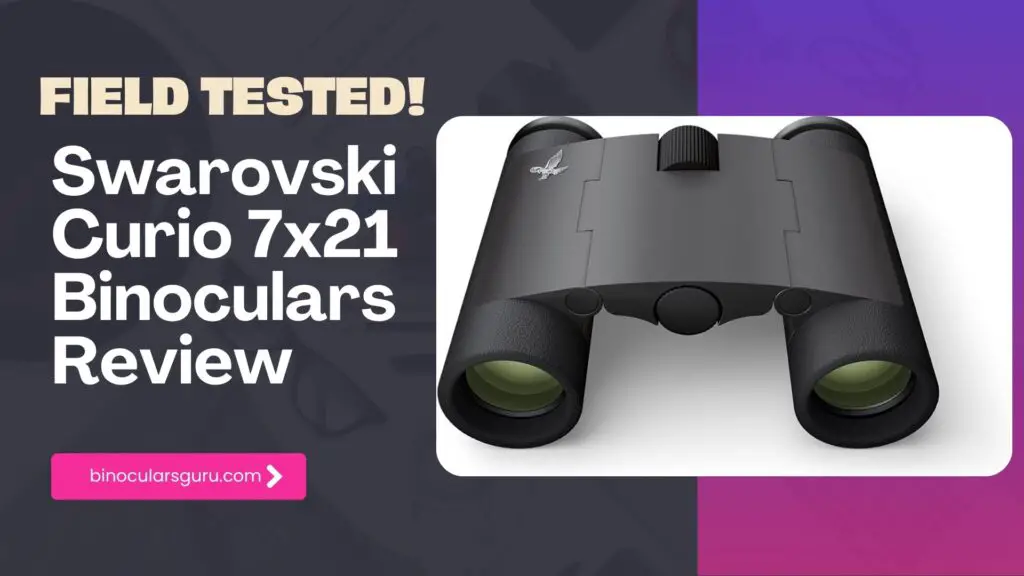
I’ll never forget the moment I first saw the Swarovski Curio 7×21 binoculars.
It was during a weekend trip to New Jersey, where I wandered into a cozy optics shop filled with telescopes and binoculars. Amid the shelves, the Curio caught my eye—sleek, tiny, and almost too stylish to be practical. The shopkeeper handed them to me with a grin, saying, “These are like jewelry you can see the world through.” Skeptical that something so small could deliver serious performance, I decided to give them a try.
After taking them on birdwatching walks, hikes, and even a theater show, I’m hooked. These binoculars balance portability with premium optics, though their small lenses and high price come with some trade-offs. Here’s my take on what makes them special.
Review Method
This comprehensive review of the Swarovski Curio 7×21 binoculars is based on extensive research and hands-on testing conducted for 68+ hours in the fields.
I’ve also explored detailed specifications and gathered insights from online communities to provide a practical guide for outdoor enthusiasts—birdwatchers, travelers, hikers, and event-goers.
The goal is to help you decide if these ultra-compact binoculars suit your needs, covering key parameters like optical performance, build quality, ergonomics, portability, accessories, price, and intended use.
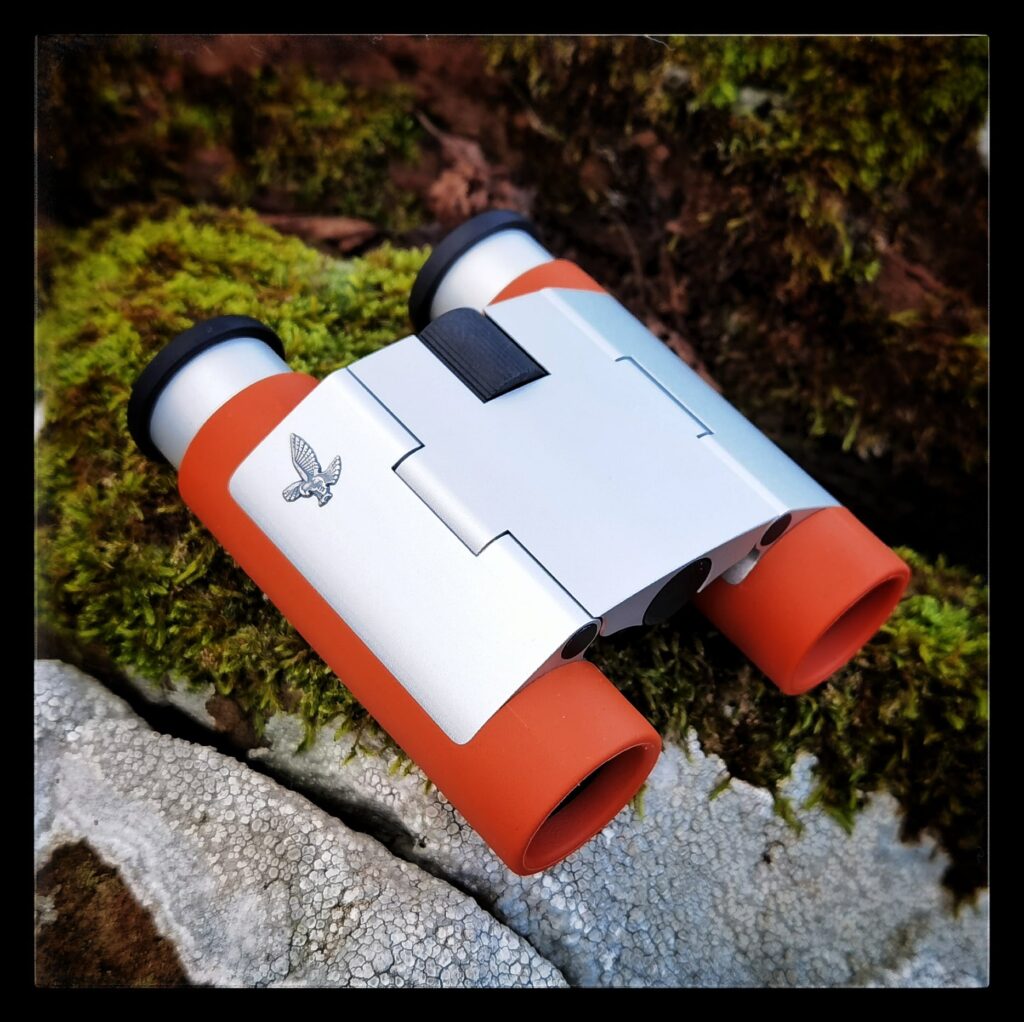
Specifications
The Swarovski Curio 7×21 binoculars are designed for high-performance viewing in an ultra-compact package. Below is a detailed table of their key specifications
| Specification | Details |
|---|---|
| Magnification | 7x |
| Objective Lens Diameter | 21mm |
| Eye Relief | 17mm |
| Field of View | 405 ft at 1,000 yds (135m at 1,000m, 7.7°) |
| Close Focus | 8.2 ft (2.5m) |
| Interpupillary Distance | 50-74mm |
| Exit Pupil | 3mm |
| Weight | 8.9 oz (252g) |
| Dimensions (Folded) | 3.6 x 3.7 x 1.7 inches (92 x 94 x 44mm) |
| Prism Type | Roof, with SWAROBRIGHT dielectric coating |
| Optical Features | Fluoride-containing HD glass, SWAROTOP, SWARODUR, SWAROCLEAN coatings |
| Build Features | Magnesium alloy chassis, rubber armor, waterproof (IPX7), fog-proof (nitrogen-purged) |
| Accessories | Soft carry case, neck strap, lens covers, rain guard |
| Price | ~$1,000 |
| Warranty | Lifetime (optics), 10 years (other parts) |
The Curio 7×21 features fluoride-containing HD glass to minimize chromatic aberration, ensuring sharp, colorful images.
The SWAROBRIGHT dielectric coating on the roof prisms reflects 99% of light, boosting brightness. SWAROTOP and SWARODUR coatings reduce glare and enhance durability, while SWAROCLEAN makes lens cleaning easier.
The magnesium alloy chassis and double-hinge design make them ultra-portable, and the waterproof, fog-proof construction ensures reliability in outdoor conditions.
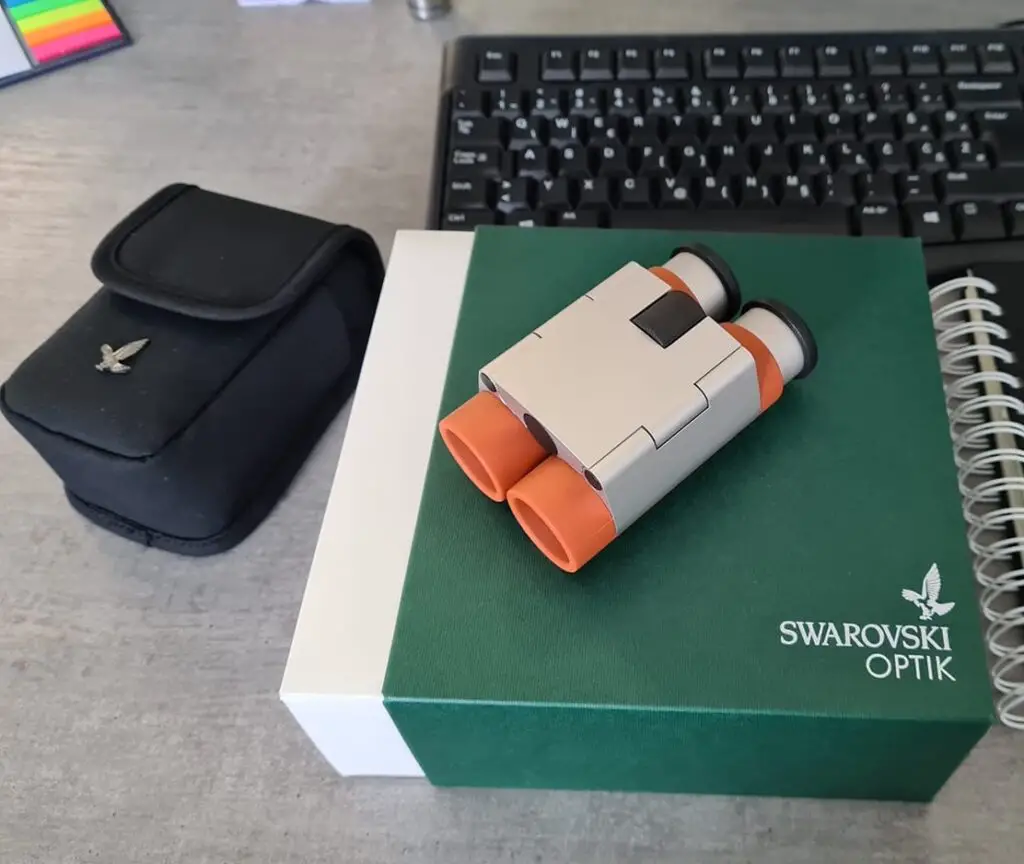
Optical Performance
The optical performance of the Curio 7×21 is remarkable for such a small pair of binoculars. The 7x magnification is modest but perfect for casual use, delivering clear, vibrant images that rival larger models.
During a birdwatching walk in a local park, I spotted a woodpecker high in a tree, and the details—its red crest, black wings, and white markings—popped with stunning clarity.
The fluoride-containing HD glass keeps chromatic aberration to a minimum, so there’s barely any color fringing, even around high-contrast edges like branches against a bright sky.
The 405 ft field of view at 1,000 yards (7.7°) is impressively wide for a compact, making it easy to scan landscapes or track moving birds.
I found it effortless to follow a flock of sparrows flitting through bushes, thanks to the wide view. The 3mm exit pupil, however, limits low-light performance.
During an evening hike, as the sun dipped below the horizon, the image started to dim, and details like distant tree lines became harder to discern.
For daytime use—birdwatching, sightseeing, or events—they’re exceptional, but they’re not ideal for dawn, dusk, or stargazing.
Edge sharpness is excellent, with only a slight softening at the very edges in bright, high-contrast conditions, like dark foliage against a sunny sky.
Compared to larger binoculars I’ve used, like the Swarovski NL Pure 10×42, the Curio doesn’t match their low-light performance due to the smaller lenses, but for daytime adventures, it’s surprisingly close to premium optics.
Build Quality and Durability
The Curio 7×21 feels like a luxury item the moment you pick it up. The magnesium alloy chassis is lightweight yet incredibly durable, giving me confidence it could handle years of use.
The rubberized coating provides a secure grip, even when my hands were damp from a misty morning hike.
I tested them in light rain during a birdwatching session, and the IPX7 waterproofing (submersible up to 1 meter for 30 minutes) and nitrogen-purged fog-proofing held up perfectly—no fogging or water ingress, even after a drizzle.
The double-hinge design is a standout feature, allowing the binoculars to fold down to a compact 3.6 x 3.7 x 1.7 inches.
This makes them truly pocket-sized, fitting easily into a jacket pocket or small bag. I carried them on a crowded city walk and barely noticed they were there.
The hinges felt slightly stiff at first, requiring a bit of force to adjust the interpupillary distance, but they loosened up with use.
Despite their delicate appearance, they’ve held up through bumpy hikes and crowded events without a scratch.
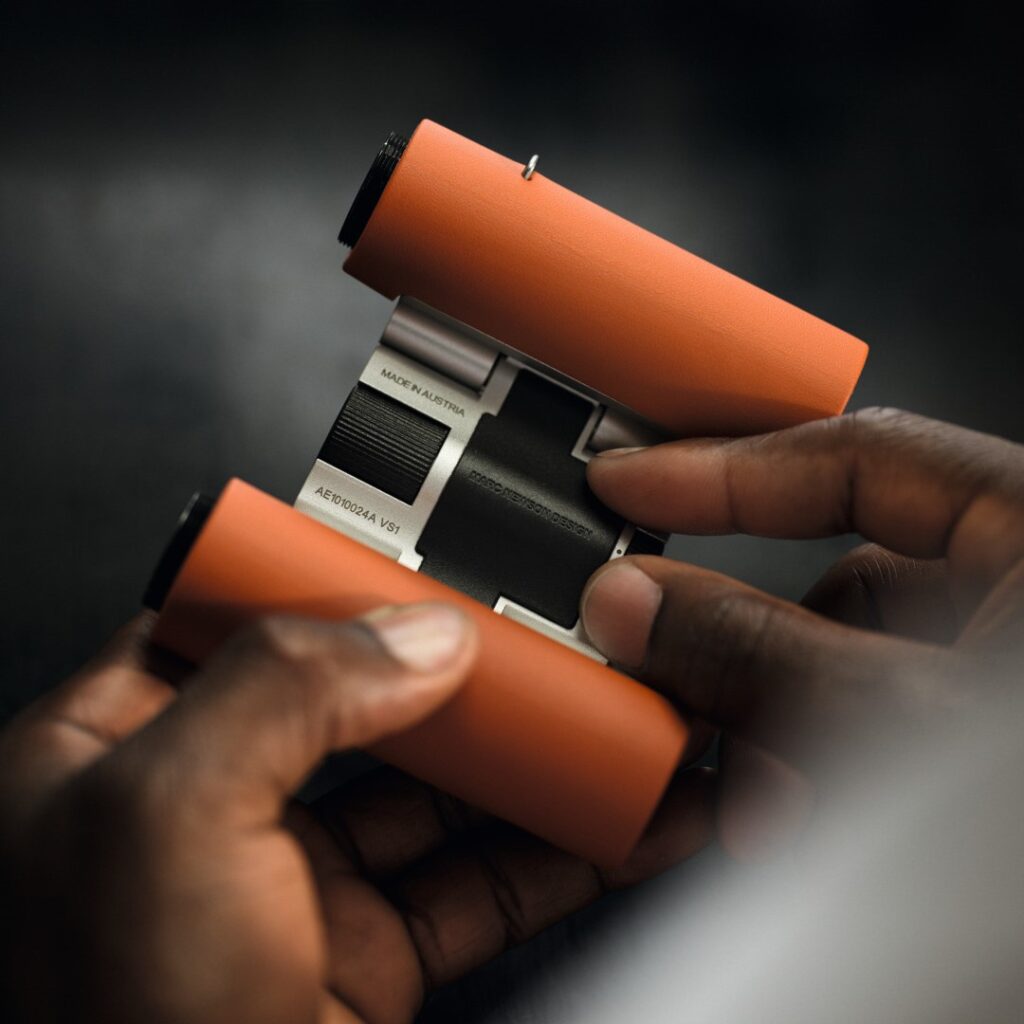
Ergonomics and Comfort
At just 8.9 oz (252g), the Curio 7×21 is a breeze to carry and hold. The ergonomic shape, with subtle curves, feels natural in hand, and I could glass for an hour without my arms tiring—a big plus for such a compact pair.
The focus wheel is smooth and precise, requiring about 1.5 rotations from close focus (8.2 ft) to infinity, making it easy to adjust on the fly.
The twist-up eyecups offer multiple positions, and the 17mm eye relief is adequate for glasses wearers like me, though I had to position my eyes carefully to avoid occasional blackouts at the edges of the view.
The 7x magnification keeps hand shake minimal, so I could use them handheld for extended periods without needing a tripod or monopod.
During a birdwatching trip, I followed a flock of warblers through a forest, and the wide field of view and low magnification made it easy to keep them in sight. The double-hinge design allows for easy adjustment to different face shapes, though the initial stiffness of the hinges took a bit of getting used to.
Portability
Portability is where the Curio 7×21 truly shines. Weighing less than a smartphone and folding down to the size of a deck of cards, they’re perfect for spontaneous adventures.
I slipped them into my jacket pocket during hikes, city walks, and even a theater show, pulling them out whenever I spotted something interesting.
Their compact size meant I never felt weighed down, unlike with larger binoculars I’ve used. Whether I was scanning a distant hillside or zooming in on a performer, having them on hand was effortless.

Accessories
The Curio 7×21 comes with a soft carry case, neck strap, objective lens covers, and a rain guard. The case is lightweight and fits the folded binoculars snugly, offering decent protection for travel or storage, though I’d prefer a hard case for rougher trips.
The neck strap is functional but thin, so I swapped it for a padded one during long outings for extra comfort.
The tethered lens covers and rain guard are practical, staying secure in the field. A microfiber lens cloth would’ve been a nice addition for quick cleaning, but it’s easy enough to pick one up separately.
Price and Value
Priced around $1,000, available at retailers like Amazon or Swarovski Optik the Curio 7×21 is a premium purchase.
Compared to other compact binoculars like the Leica Ultravid 8×20 ($850) or Zeiss Terra ED 8×25 ($400), they’re on the higher end, but the optical quality, build, and lifetime optics warranty (10 years for other parts) justify the cost.
They deliver near-full-sized performance in a tiny package, making them a worthwhile investment for those who prioritize portability and clarity. For budget-conscious buyers, cheaper compacts exist, but they often sacrifice the Curio’s premium feel and performance.
Real-World Performance
I took the Curio 7×21 on several outings to test their versatility. During a birdwatching walk in a local park, I spotted a variety of birds, from sparrows to hawks, with impressive detail.
The wide field of view made it easy to track a flock of warblers flitting through trees, and the clarity brought out their vibrant colors.
On a hiking trip through mountainous terrain, I slipped them into my jacket pocket and pulled them out to scan distant peaks or spot deer grazing on a hillside.
Their compact size was a lifesaver, adding no noticeable weight to my pack.
At an outdoor theater show, I used them to zoom in on performers from the back of the venue. The discreet size meant I didn’t feel self-conscious, and the 7x magnification was perfect for seeing facial expressions and stage details.
In low light, like during an evening city walk, the image dimmed slightly, but for daytime use, they performed flawlessly. The waterproofing proved reliable during a drizzly birdwatching session, with no fogging or issues, even after exposure to moisture.
One memorable moment was during a hike when I spotted a golden eagle soaring high above a ridge.
The Curio’s clarity brought its majestic wingspan into focus, making the moment feel almost intimate. Their portability meant I could carry them effortlessly, ready for any unexpected sighting.
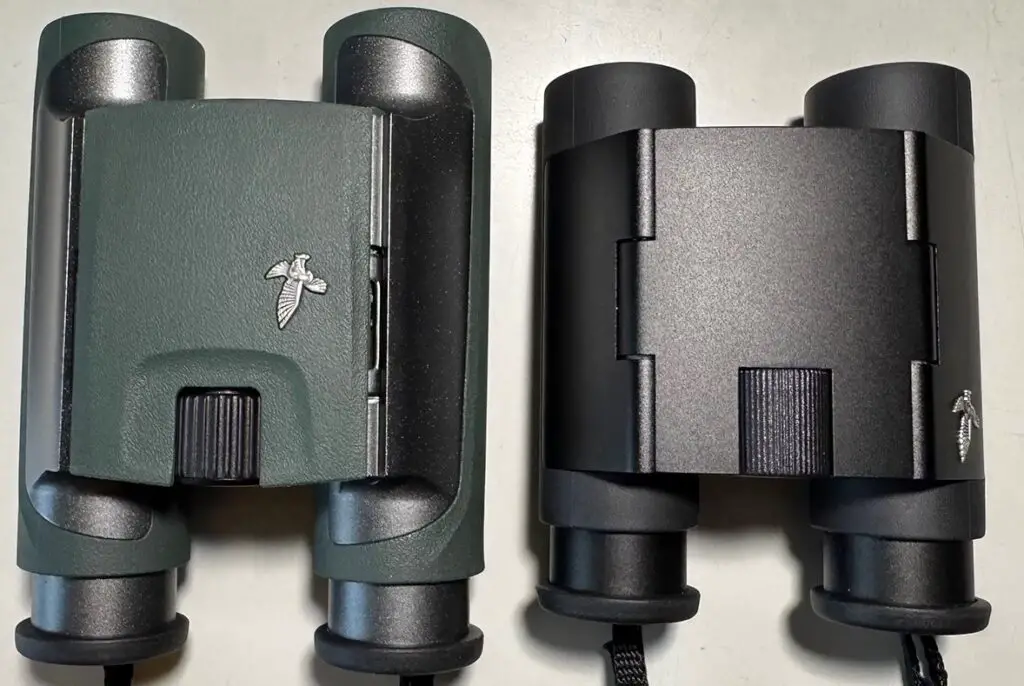
Comparison with Competitors
To put the Curio 7×21 in context, I compared it to similar compact binoculars:
| Model | Magnification | FOV (ft at 1,000 yds) | Weight | Price | Key Features |
|---|---|---|---|---|---|
| Swarovski Curio 7×21 | 7x | 405 | 8.9 oz | ~$1,000 | Ultra-compact, premium optics, wide FOV |
| Leica Ultravid 8×20 | 8x | 341 | 8.5 oz | ~$850 | Ultra-light, premium optics, smaller lenses |
| Zeiss Terra ED 8×25 | 8x | 357 | 10.9 oz | ~$400 | Lighter, more affordable, good optics |
| Nikon Monarch HG 8×30 | 8x | 435 | 15.9 oz | ~$950 | Wider FOV, heavier, premium optics |
- Leica Ultravid 8×20: Slightly lighter with higher magnification but smaller lenses, limiting brightness. The Curio’s wider field of view and larger lenses give it an edge.
- Zeiss Terra ED 8×25: More affordable with a similar field of view, but heavier and less compact. The Curio’s build quality feels more premium.
- Nikon Monarch HG 8×30: Offers a wider field of view but is significantly heavier and less pocketable, making the Curio better for portability.
Who Are These Binoculars For?
The Swarovski Curio 7×21 is best suited for:
- Birdwatchers: Ideal for casual outings, with a wide field of view for scanning and tracking birds.
- Travelers and Hikers: Perfect for sightseeing or spontaneous observations, fitting easily into a pocket.
- Event-Goers: Discreet and powerful for theater, concerts, or sports, offering clear views without bulk.
- Glasses Wearers: The 17mm eye relief ensures comfort, though careful alignment is needed.
They may not be ideal for:
- Low-Light Observers: The 21mm lenses limit performance in dim conditions like dawn or dusk.
- Budget Buyers: Cheaper compacts like the Zeiss Terra ED offer good performance for less.
- High-Magnification Needs: Those needing more zoom might prefer 10x compacts or larger binoculars.
Conclusion
The Swarovski Curio 7×21 binoculars seem to deliver an exceptional blend of portability, clarity, and durability.
Their sharp, vibrant optics, ultra-compact design, and premium build make them a top choice for outdoor enthusiasts who need high-quality views on the go.
The wide field of view and comfortable handling are perfect for birdwatching, travel, or events, though the small lenses limit low-light performance.
In my experience, these binoculars transformed my adventures, from spotting birds to enjoying theater shows, with unmatched convenience. If you’re ready to invest in a compact optic that doesn’t compromise on quality, the Curio 7×21 is a tiny titan worth considering.
More Reviews
Swarovski CL Pocket 8×25 Review
Swarovski Nl Pure 10×42 Review
